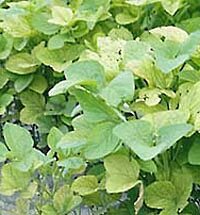
-
Soybean Diseases
- Asian Rust
- Anthracnose
- Bacterial Blight
- Bacterial Pustule
- Bean Pod Mottle Virus
- Brown Stem Rot
- Cercospora Leaf Blight
- Charcoal Rot
- Downy Mildew
- Frogeye Leaf Spot
- Green Stem Syndrome
- Iron Deficiency Chlorosis
- Phytophthora Root & Stem Rot
- Powdery Mildew
- Rhizoctonia
- Seedling Diseases
- Septoria (Brown Spot)
- SCN (Soybean Cyst Nematode)
- Soybean Mosaic Virus
- Stem Canker
- Sudden Death Syndrome
- Viruses
- White Mold
- Soybean Pests
- Diagnostic Help
- Field Trials
- Soybean Library
| Disease: Iron Deficiency Chlorosis |
Your Soybean Checkoff.
Delivering Results.
Illinois
Indiana
Iowa
Kansas
Michigan
Minnesota
Missouri
Nebraska
North Dakota
Ohio
South Dakota
Wisconsin
Iron Deficiency Chlorosis
 |
| . |
|
Iron deficiency is characterized by yellowing between veins, while veins remain dark green.
Photo credit: Edwin J. Penas and Richard A. Wiese, University of Nebraska |
Iron deficiency chlorosis (IDC) of soybean is a physiological disease caused by iron deficiency in the plant. It is an important production issue in some fields, and pockets within fields, that can result in substantial yield loss.
IDC is not caused by a lack of iron in the soil, but by an inability of the plant to take it up. Soybean is particularly susceptible to IDC. Soybean plants obtain iron from the soil by releasing acids into the soil to solubilize the iron into a form readily taken up by the roots. In high pH soils with high levels of bicarobonates, however, this process can be limited by the chemical reactions between the bicarbonates and the iron.
Iron is necessary for the formation of chlorophyll, which is the green pigment in plants. If not enough iron is taken up by the plant, yellowing between the leaf veins occurs, and growth and yield are affected. Because iron is immobile in the plant, the deficiency will manifest in the younger leaves first.
